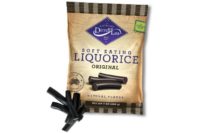![]()
Thinking Big At Eby-Brown
Eby-Brown at a Glance |
| Ownership: Privately held wholesale distributor.
Co-Presidents/Co-CEOs: Tom and Dick Wake. Corporate Objective: To be the dominant convenience channel wholesaler in the Eastern half of the United States. Sales: $3.8 billion Total Non-Cigarette Sales Volume: $661 million Candy and Snack Sales: $205 million Number of Stores Served: 25,000 Retail Channel Focus: Convenience Number of Candy and Snack SKUs: 4,600 Distribution Centers: Eight |
John Scardina on the Limitations
of Limited Editions |
| How does Eby-Brown’s John Scardina rate
candy vendors in terms of innovation? "I’m happy to say that I think we’re starting to see some improvement," he says, Until recently, he says, "I think you’ve had vendors relying too heavily on line extensions as opposed to being innovative. It’s great to have a line extension. But does it really add to the category? Does it create an incremental opportunity? I don’t think it does over the long term. I think it plays off the strength of the key brand and may draw that consumer who is used to having XYZ flavor over to the new flavor." For the most part, Scardina says, he considers limited-edition programs "just a glorified way of doing a line extension," so he’s got some concerns about the proliferation of limited edition items. He’s adamant about this perspective, despite the fact that line extensions have been strong performers over the past year and a half. "As a wholesaler, our job is to make sure that we provide items to retailers – especially the new items. As some point, you do look at these new products and say, ‘There’s been a lot of duplication and how many variations on a theme are you going to have before you’ve blurred the line so much that nobody knows what the original brand is all about?" "I think we may be getting close to the time when they [limited edition products] have run their course," he predicts. |
Rating Recent Rollouts |
| Here is John Scardina’s take on several
recent or upcoming introductions from candy companies.
Skittles Fruit Gum – "It’s a very fun gum that I think kids will glom on to." Hershey’s 1 Gram Sugar Carb Bar – "It’s a good line. They’re trying to play it safe with the label, which is fine. The label doesn’t scream low-carb, it screams low sugar carbs." Altoids Gum – "It’s a great-tasting piece of gum. It’s something of a line extension, but it’s for a somewhat different consumer than the Altoids mints. There are mint consumers. There are gum consumers." Hershey’s S’Mores Bar – "The bar has a good taste and texture, it’s something new and different. I think it will add to the category." M-Azing Crunchy and |
Family: Wife, Missy. Step-children: Aaron, 17;
Courtney, 14.
Cooking and entertaining friends and family. Golf. Also serves his community as a member of the board of directors of the Batavia Foundation for Educational Excellence, a group that awards grants to support academic programs and projects not routinely funded in school budgets.
The paperwork!
"Stretch yourself. Know at least a little bit about a lot of different things."





